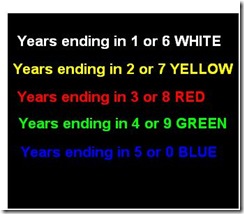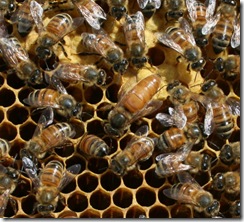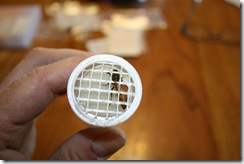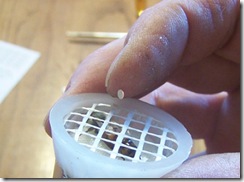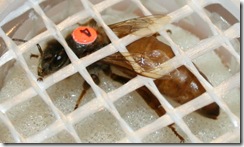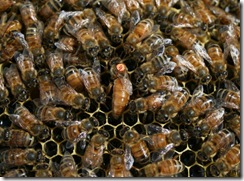Marking A Queen
Marking The Queen
 Without the queen the hive will perish, and perish fast! New beekeepers fail to realize how crucial it is to have a healthy queen, and how fast a hive will die when the queen perishes.
Without the queen the hive will perish, and perish fast! New beekeepers fail to realize how crucial it is to have a healthy queen, and how fast a hive will die when the queen perishes.
Are you tired of having to buy queens! Consider taking my ONLINE QUEEN REARING COURSE from the comfort of your home. You can learn to raise your own queens by taking my course. You'll receive links to our how to video links along with worksheets. Stop paying for queens and raise your own. This course can be taken whenever you want, at your own pace, in the comfort of your home. Now learn to raise queens on your schedule without being intimidated in a classroom. Click here to sign up now.
But if you have to buy a queen, I'll sell you one :)
Sure, the colony will try to raise another queen, but to do that several factors have to work perfectly. Needless to say, we do not live in a perfect world and the colony does not always get the job done in time and remain queenless and perish--and fast!
Because of this, queens are in short supply and in extreme high demand.There are plenty of apiaries that sell queens, but usually you have to wait two weeks or more before they can ship. Here's the problem: Queens that die now, say in May, are hard to find replacement for until June. A hive will be too far gone if a they have to wait more than two weeks for a queen.
You must have a queen supplier's number in your speed dial! You must have a good source for queens or else you could lose your hive fast. Think about this for a moment. We pay alot for a package of bees, but if we lose the queen, we can lose the entire colony and the entire cost of the package. We sell our Queens sell for $39 which is a small investment to keep the hive alive and growing.
For the most part, queens stay out of trouble and avoid calamity. But, not always. As she ages, she can be ousted by the bees due to her poor performance in laying eggs. Not to mention our inspections pose the greatest threat to her. Moving frames, smashing lids down, prying hive bodies apart and smashing them together can lead to the queen being killed. I accidentally smashed and killed a queen Sunday. I know to watch carefully, but this time I never saw where she was and smashed her dead. It happens. We must be more careful not to kill the queen when working our hives.
I've never been too keen on marking queens. For one, it is costly and time consuming. And since there are no Africanized hives in Illinois, I'm not worried about my queens being superseded by Africanized queens. Without marked queens, you can never tell if your original queen has been replaced.
A marked queen is beneficial because it aids the beekeeper in identifying the queen more quickly, thus knowing where the queen is so as not to accidentally kill her. It also allows us to keep detailed records on a specific queen, particularly her age and performance.
Also, when making splits, the queen can get moved around, so by having her marked and numbered you'll always know the history of that particular queen no matter where you place her.
In the past I would occasionally mark certain queens by picking them up and holding them by their legs and mark their thorax. Even whiteout works fine. Testors model paint works better but takes a few minutes longer to allow it to dry.
Let me show you how you too can number/color code your queens yourself. It is very easy and you'll feel like a professional entomologist when you're done.
If this is too complicated, consider taking our ONLINE QUEEN REARING COURSE NOW from the comfort of your home, on your schedule.
First, you must know that there is an International Color Code system for marking queens. Do not just mark your queens any color. You'll forget what year you started with them. Here's how the color code works:
The span between years is 5 years. It would be next to impossible for the queen to live that long, so you would not have to wonder if the red dot meant 2008 or 2013.
So how in the world can you mark a queen. We sell the complete kit for marking your queens or bees too, but let me walk you through step by step.
Okay, first open up your hive and locate your queen. Here's mine. I found her fast because it was a newly install package, and not a full hive.
Next I gently chase her down and pick her up by her wings or thorax, the middle section just behind her head.
In the field, I have my marking system in hand, which is a plastic tube with a removable plunger in one end, and a screened opening in the other.  I place her in there while holding everything over the hive, incase she falls off, she's back in her hive and not in the grass somewhere.
I place her in there while holding everything over the hive, incase she falls off, she's back in her hive and not in the grass somewhere.
Next, I slowly push up the plunger being careful not to snag a leg or wing. I wait until the queen stands on the plunger, then I slide her up to the screen. When she is close to the top, I slow down and carefully slide the plunger until the top of her thorax pokes up through the screen. It may seem like you are smashing her, but you don't want to push any harder than just to hold her thorax in a screen square as in this picture. You can click on the picture for a larger view.
Next, I punch out one of the numbers from the numbering kit that comes with this complete marking kit. For this queen, I've chosen number 4 and of course in keeping with the International Color Coding system, I've chosen the color red. This kit also comes with non-toxic glue. I put a little glue on the back side of the number, and carefully place it on her thorax. I press down gently to give it a good seat. I hold her in this position for a minute or two allowing the glue to dry. I have big hands so I wear a jeweler's magnifying glass for better placement and control. We sell these as well if you need one. At 48, my close up eyesight is not what it used to be :)
Now, she is numbered and ready to be returned to her hive. I make sure she is over the hive, very close down to a frame before pulling out the plunger. Sometimes she does not immediately drop out so I gently shake her out onto the frames.
For your sake, I pulled out the frame to show you how proud she is of her new number and notice how impressed all the other bees are as they stare and marvel over her new red number four.
Also, now I can keep a notebook and make any kind of notations on queen number 4 that I want. If she is ever replaced, I'll know it as well, because her replacement will not wear the number 4.
Marking worker bees is a bit harder because this system is made for a larger queen and the smaller workers squeeze through the top screen. But, with a little patience I was able to pin them at just the right moment and number them.
You don't have to use numbers if you don't want to mess with the glue and numbering system. We sell a paint pen, so that when you pin her thorax up through the screen, you can put on a touch of paint.
In summary, a marked queen is not essential. However, there are benefits that make it worth the while as you have discovered in this lesson. The marking systems are affordable and easy to use.
